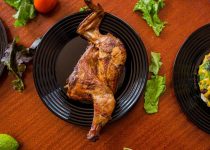How to Truss a Chicken for Rotisserie Weber
Trussing a chicken for the rotisserie Weber may seem daunting at first, but with the right guidance, you'll soon master this essential skill.
Trussing ensures that the chicken cooks evenly and retains its juiciness, resulting in a mouthwatering meal.
With a few simple steps and some practice, you'll be trussing like a pro in no time.
Let's dive in and learn how to prepare your chicken for the rotisserie, so you can enjoy perfectly cooked, flavorful poultry every time.
Key Takeaways
- Consider the size and weight of the chicken for even cooking and optimal flavor.
- Use sturdy and heat-resistant twine for trussing.
- Tying secure trussing knots is essential for even cooking and maintaining the chicken's shape.
- Proper positioning and trussing ensure even cooking and prevent burning.
Selecting the Right Chicken
To select the right chicken for rotisserie cooking on a Weber grill, consider the size and weight of the bird to ensure even cooking and optimal flavor. A smaller chicken, around 3 to 4 pounds, is ideal as it cooks more evenly and quicker on the rotisserie. Larger birds can be challenging to cook evenly without drying out.
When choosing a chicken, also think about the benefits of brining. Brining the chicken before cooking can enhance its juiciness and flavor. It involves soaking the bird in a solution of water, salt, and sugar, sometimes with added herbs or spices, for a few hours before cooking. This process helps the chicken retain moisture during the cooking process, resulting in a juicier and more flavorful end product.
Preparing the Trussing Equipment
So, you've got your chicken ready and now it's time to get your trussing equipment prepared.
First things first, make sure you have the proper trussing twine on hand.
Then, we'll walk you through how to tie secure trussing knots and ensure that your chicken is trussed evenly for the rotisserie.
Let's get started!
Selecting Proper Trussing Twine
Make sure you've got a sturdy and heat-resistant twine to truss your chicken securely for the rotisserie. When choosing the right twine, consider the following:
- Material: Look for twine made of cotton or butcher's twine, which can withstand the heat of the rotisserie without melting or burning. Natural fibers like cotton are ideal for trussing as they're strong and food-safe.
- Thickness: Opt for a medium thickness twine that's strong enough to hold the chicken together but not too thick that it becomes difficult to tie knots. A thickness of around 1/8 to 1/4 inch is suitable for trussing poultry and allows for easy knot tying techniques.
Selecting the proper trussing twine is crucial for ensuring your chicken cooks evenly and stays secure on the rotisserie.
Tying Secure Trussing Knots
Once you have selected the proper trussing twine, you can begin preparing the trussing equipment by securing the chicken and ensuring it is ready for the rotisserie. Tying secure trussing knots is essential to keep the chicken intact and ensure even cooking. Here are some trussing tips and techniques to help you achieve the perfect truss:
| Trussing Tip | Description |
|---|---|
| Start with Enough Twine | Begin with a long enough piece of twine to comfortably truss the chicken without running out. |
| Cross and Loop | Cross the twine under the chicken's body, then loop it around the legs and cross it back over the top. |
| Pull Tight | Make sure to pull the twine tight after each wrap to secure the chicken firmly. |
| Double Knot | Finish with a double knot to keep the trussing in place during the rotisserie cooking process. |
Mastering these tying techniques will ensure your chicken cooks evenly and looks great on the rotisserie.
Trussing Chicken Evenly
To truss a chicken evenly for the rotisserie Weber, start by securing the chicken and ensuring it's ready for the rotisserie by using a double preposition.
First, gather your trussing equipment, including kitchen twine and scissors, to ensure a smooth trussing process.
Next, prepare the chicken by removing any excess fat and tucking the wings behind the back to promote even cooking.
Now, let's discuss trussing techniques. Place the chicken breast-side up with the legs facing towards you.
Cross the legs and tie them together using kitchen twine, ensuring a snug fit to maintain the shape of the chicken.
Then, loop the twine around the wings and cinch them close to the body.
This meticulous trussing will help the chicken cook evenly, resulting in a delicious rotisserie chicken.
Positioning the Chicken for Trussing
After you have cleaned and prepared the chicken, carefully lay it breast side down on a clean work surface. Positioning the chicken properly is crucial for trussing it effectively.
To do this, extend the wings away from the body, and tuck the tips under the bird. This not only helps the chicken cook evenly on the rotisserie but also prevents the wingtips from burning.
Next, tie a piece of kitchen twine around the legs, close to the body, and cross the twine over the top of the legs. Then, flip the chicken over and bring the twine around the ends of the drumsticks, pulling them together firmly. This step ensures the chicken holds its shape during the rotisserie cooking process.
Once the chicken is properly positioned and trussed, it's ready to be seasoned and placed on the rotisserie spit for a succulent and evenly cooked result. Mastering these positioning and trussing techniques will elevate your rotisserie chicken game to a whole new level.
Tying the Legs and Wings
Start by securing the twine around the legs, cross it over the top of the legs, and then bring it around the ends of the drumsticks to tie them together firmly. This tying technique helps to hold the chicken's shape together and ensures even cooking on the rotisserie.
Here are a few key points to keep in mind as you tie the legs and wings:
- Use the Right Tools:
- Having the right trussing tools, such as kitchen twine and a sturdy pair of kitchen shears, can make the process much easier and more efficient.
- Make sure the twine is strong enough to securely hold the legs and wings in place during the cooking process.
- Maintain Even Tension:
- When tying the legs and wings, aim to maintain even tension throughout to ensure that the chicken is trussed securely and evenly.
- Avoid tying the twine too tightly, which could cause the chicken to cook unevenly.
Mastering the art of tying the legs and wings is an essential step in trussing a chicken for rotisserie cooking. With the right technique and tools, you'll be well on your way to achieving perfectly cooked, succulent chicken every time.
Securing the Trussing Knots
Now, let's talk about securing those trussing knots!
This step is crucial because it ensures that the chicken is tightly bound, allowing for even cooking on the rotisserie.
The tightness of the trussing knots will play a big role in the final result, so let's make sure to get it just right.
Tightness of Trussing
Securing the trussing knots is essential for ensuring that the chicken is evenly cooked on the rotisserie. The tightness of the trussing directly impacts both the cooking results and the flavor retention of the chicken.
To achieve optimal trussing tightness, consider the following:
- Trussing Tightness, Cooking Results
- Even trussing ensures uniform cooking, preventing uneven doneness in different parts of the chicken.
- Properly secured trussing helps the chicken maintain its shape, promoting even browning and a visually appealing final product.
Ensuring Even Cooking
To ensure even cooking, firmly secure the trussing knots to maintain the chicken's shape and promote uniform browning on the rotisserie. Properly securing the trussing knots is essential for temperature control and even cooking.
If the knots are loose, the chicken may lose its shape, leading to uneven cooking and potential drying out in some areas. When tying the knots, ensure they're tight enough to hold the chicken together but not so tight that it distorts the shape. This will help the chicken cook evenly and retain its moisture, resulting in a juicy and flavorful bird.
Additionally, securing the trussing knots properly also helps in brining techniques and flavor infusion, ensuring that the chicken absorbs the flavors evenly and cooks consistently throughout.
Ready for the Rotisserie
First, you'll want to place the trussed chicken on the rotisserie spit, ensuring it's evenly balanced. This is crucial to guarantee even cooking and to prevent the motor from straining. Once the chicken is securely on the spit, you're almost ready to start the rotisserie.
- Rotisserie Cooking Techniques and Seasoning
- Season the chicken liberally with your favorite rub or marinade. Ensure that the seasoning is applied evenly for a delicious flavor in every bite.
- Familiarize yourself with the rotisserie cooking techniques. Adjust the heat settings and position the chicken in the center of the rotisserie for optimal results.
Now that the chicken is prepared and on the rotisserie, take a moment to ensure your rotisserie is in good condition.
- Rotisserie Maintenance and Cleaning
- Before use, make sure the rotisserie spit and forks are clean and free from any leftover food particles. A clean rotisserie ensures that your chicken will cook evenly and without any unpleasant flavors.
- Regularly clean your rotisserie after each use to prolong its lifespan and maintain its performance. This simple maintenance routine will ensure that you get the best results from your rotisserie cooking.
With these steps complete, your chicken is ready to start rotating and cooking to perfection on the rotisserie. Enjoy the mouthwatering aromas as your chicken turns golden brown and succulent.
Frequently Asked Questions
How Long Should I Let the Chicken Rest Before Trussing It for Rotisserie Cooking?
Before trussing the chicken for rotisserie cooking, let it rest for at least 15 minutes. This allows the meat to relax, making it easier to truss. Season the chicken with your favorite rotisserie seasoning, then cook it at the recommended temperature for delicious results.
Can I Use a Different Type of Poultry, Such as Turkey, With the Same Trussing Method?
Yes, you can use the same trussing methods for alternative poultry like turkey. Ensure you have the right trussing equipment, cooking twine, and metal skewers for secure trussing. Adjustments may be needed for larger birds.
What Are Some Common Mistakes to Avoid When Trussing a Chicken for Rotisserie Cooking?
When trussing a chicken for rotisserie cooking, common mistakes to avoid include improper technique, such as tying knots too tightly or leaving gaps. Proper technique involves securing the wings and legs, ensuring even cooking.
How Can I Adjust the Trussing Method for a Larger or Smaller Chicken?
To adjust the trussing method for different poultry sizes, use longer trussing material for larger birds and shorter for smaller ones. Allow the chicken to rest after trussing to ensure even cooking.
Can I Use a Different Type of Trussing Material, Such as Cooking Twine or Metal Skewers, Instead of the Recommended Trussing Equipment?
You can definitely use different trussing materials like cooking twine or metal skewers as alternatives. They offer flexibility and can be adjusted to fit the size of your chicken. Experiment with different options to find what works best for you.



